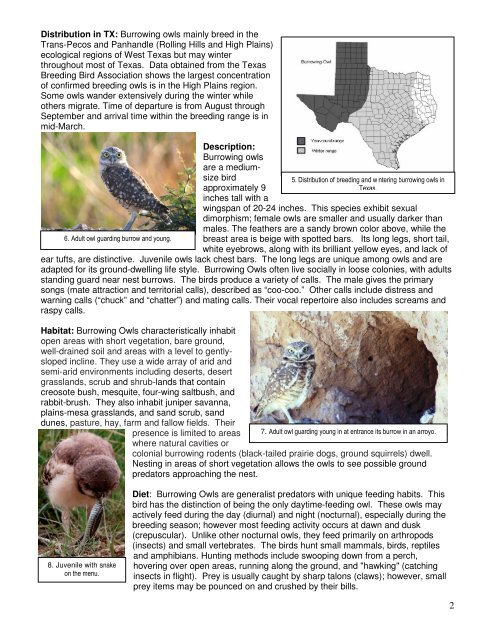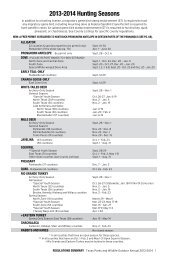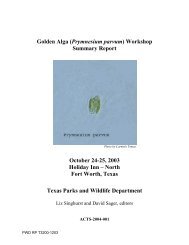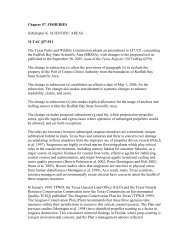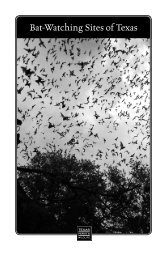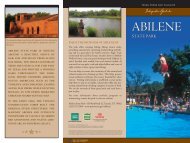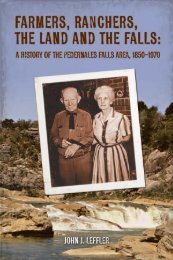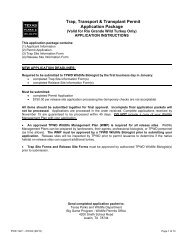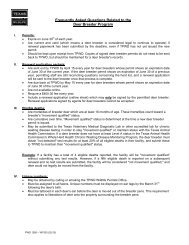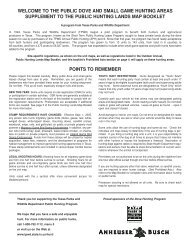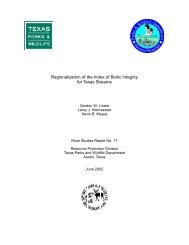1 burrowing owls of the trans-pecos and panhandle regions of texas
1 burrowing owls of the trans-pecos and panhandle regions of texas
1 burrowing owls of the trans-pecos and panhandle regions of texas
Create successful ePaper yourself
Turn your PDF publications into a flip-book with our unique Google optimized e-Paper software.
Distribution in TX: Burrowing <strong>owls</strong> mainly breed in <strong>the</strong><br />
Trans-Pecos <strong>and</strong> Panh<strong>and</strong>le (Rolling Hills <strong>and</strong> High Plains)<br />
ecological <strong>regions</strong> <strong>of</strong> West Texas but may winter<br />
throughout most <strong>of</strong> Texas. Data obtained from <strong>the</strong> Texas<br />
Breeding Bird Association shows <strong>the</strong> largest concentration<br />
<strong>of</strong> confirmed breeding <strong>owls</strong> is in <strong>the</strong> High Plains region.<br />
Some <strong>owls</strong> w<strong>and</strong>er extensively during <strong>the</strong> winter while<br />
o<strong>the</strong>rs migrate. Time <strong>of</strong> departure is from August through<br />
September <strong>and</strong> arrival time within <strong>the</strong> breeding range is in<br />
mid-March.<br />
6. Adult owl guarding burrow <strong>and</strong> young.<br />
Description:<br />
Burrowing <strong>owls</strong><br />
are a mediumsize<br />
bird<br />
approximately 9<br />
inches tall with a<br />
5. Distribution <strong>of</strong> breeding <strong>and</strong> wintering <strong>burrowing</strong> <strong>owls</strong> in<br />
Texas.<br />
wingspan <strong>of</strong> 20-24 inches. This species exhibit sexual<br />
dimorphism; female <strong>owls</strong> are smaller <strong>and</strong> usually darker than<br />
males. The fea<strong>the</strong>rs are a s<strong>and</strong>y brown color above, while <strong>the</strong><br />
breast area is beige with spotted bars. Its long legs, short tail,<br />
white eyebrows, along with its brilliant yellow eyes, <strong>and</strong> lack <strong>of</strong><br />
ear tufts, are distinctive. Juvenile <strong>owls</strong> lack chest bars. The long legs are unique among <strong>owls</strong> <strong>and</strong> are<br />
adapted for its ground-dwelling life style. Burrowing Owls <strong>of</strong>ten live socially in loose colonies, with adults<br />
st<strong>and</strong>ing guard near nest burrows. The birds produce a variety <strong>of</strong> calls. The male gives <strong>the</strong> primary<br />
songs (mate attraction <strong>and</strong> territorial calls), described as “coo-coo.” O<strong>the</strong>r calls include distress <strong>and</strong><br />
warning calls (“chuck” <strong>and</strong> “chatter”) <strong>and</strong> mating calls. Their vocal repertoire also includes screams <strong>and</strong><br />
raspy calls.<br />
Habitat: Burrowing Owls characteristically inhabit<br />
open areas with short vegetation, bare ground,<br />
well-drained soil <strong>and</strong> areas with a level to gentlysloped<br />
incline. They use a wide array <strong>of</strong> arid <strong>and</strong><br />
semi-arid environments including deserts, desert<br />
grassl<strong>and</strong>s, scrub <strong>and</strong> shrub-l<strong>and</strong>s that contain<br />
creosote bush, mesquite, four-wing saltbush, <strong>and</strong><br />
rabbit-brush. They also inhabit juniper savanna,<br />
plains-mesa grassl<strong>and</strong>s, <strong>and</strong> s<strong>and</strong> scrub, s<strong>and</strong><br />
dunes, pasture, hay, farm <strong>and</strong> fallow fields. Their<br />
presence is limited to areas<br />
where natural cavities or<br />
colonial <strong>burrowing</strong> rodents (black-tailed prairie dogs, ground squirrels) dwell.<br />
Nesting in areas <strong>of</strong> short vegetation allows <strong>the</strong> <strong>owls</strong> to see possible ground<br />
predators approaching <strong>the</strong> nest.<br />
7. Adult owl guarding young in at entrance its burrow in an arroyo.<br />
8. Juvenile with snake<br />
on <strong>the</strong> menu.<br />
Diet: Burrowing Owls are generalist predators with unique feeding habits. This<br />
bird has <strong>the</strong> distinction <strong>of</strong> being <strong>the</strong> only daytime-feeding owl. These <strong>owls</strong> may<br />
actively feed during <strong>the</strong> day (diurnal) <strong>and</strong> night (nocturnal), especially during <strong>the</strong><br />
breeding season; however most feeding activity occurs at dawn <strong>and</strong> dusk<br />
(crepuscular). Unlike o<strong>the</strong>r nocturnal <strong>owls</strong>, <strong>the</strong>y feed primarily on arthropods<br />
(insects) <strong>and</strong> small vertebrates. The birds hunt small mammals, birds, reptiles<br />
<strong>and</strong> amphibians. Hunting methods include swooping down from a perch,<br />
hovering over open areas, running along <strong>the</strong> ground, <strong>and</strong> "hawking" (catching<br />
insects in flight). Prey is usually caught by sharp talons (claws); however, small<br />
prey items may be pounced on <strong>and</strong> crushed by <strong>the</strong>ir bills.<br />
2


